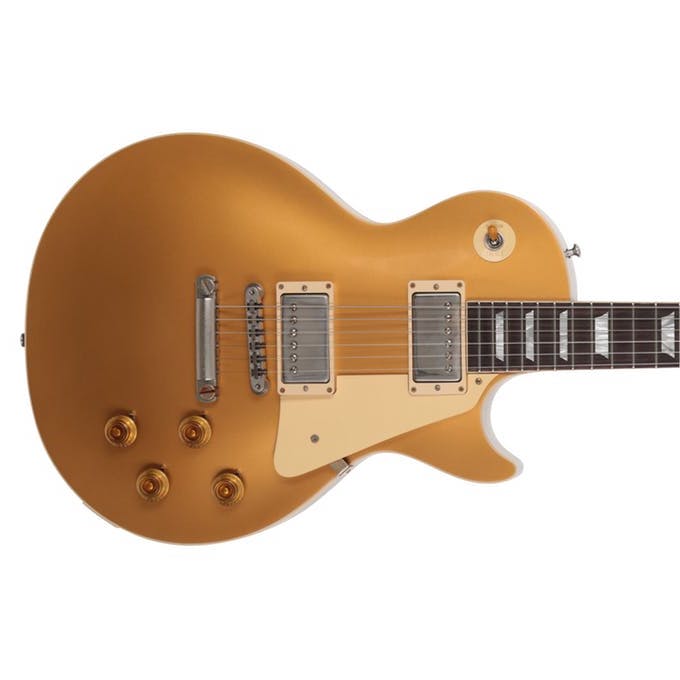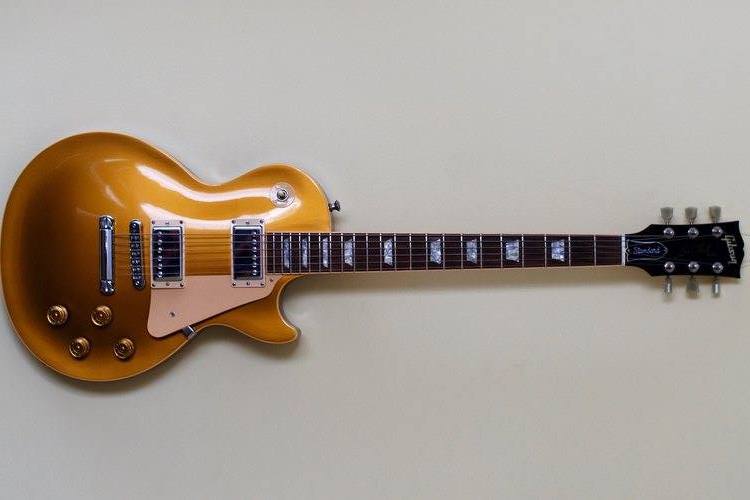
Gibson Goldtop Traditional Les Paul
Repair log – 2009 Gibson Goldtop Traditional Les Paul SN 00939030, made Nashville USA.
Current value range – £1,104 to £1,499 in excellent condition (but with original pickups)
Purchased used for £1,000, Weight = 4.3Kg, 9.48lbs
© Terry Relph-Knight 23/03/19
Received with a Gibson hard case.
This Traditional Les Paul is close to the original specifications for the 59 Les Paul. It has a chunky symmetrical C shaped neck, conventional controls with no switching options and only a small amount of weight relief. This is still a heavy guitar. The Standard model Les Paul has an asymmetric neck carve, a number of switching options added to the controls and modern weight relief.
Introduced in 1983, ‘traditional’ weight relief means nine large blind holes are drilled in the mahogany under the forearm area and covered by the maple cap.
Body – 2 piece centre joined light coloured mahogany, with a carved maple cap. Apparently with some weight relief (traditional). Gold top and clear coat back and sides nitro-cellulose. Cream binding around the top edge. There is a small, but deep, dent in the outside of the cutaway horn and mild buckle rash that does not go through the finish on the back.
Neck – Set, one piece, neck of a much darker piece of mahogany. It looks natural rather than stained, this model of Les Paul seems to usually have been made with lighter coloured necks of the same shade as the body wood, with the the usual two (lighter coloured) wings to make up the headstock width. 22 wide, flat dressed, frets on a light coloured, 12 inch radius rosewood fretboard. The fretboard isn’t super smooth, Gibson never seem to sand these very well. Pearloid trapezoid inlays above the 3,5,7,9,12,15,17,19 and 21st frets. The neck is bound with cream plastic and the binding is nibbed at the fret ends. Truss rod adjustment is as usual at the headstock with a 5/16 inch brass hex nut. The two ply ‘bell’ truss rod cover, with Traditional printed on it in white script, is unfortunately broken and cracked around both fixing holes.
Hardware
Tuners are real Kluson Deluxe (the Kluson brand is now owned by, and manufactured for, WD Music ), 3 on a side box tuners with ‘green’ plastic, single ring, tulip buttons. The tuners are attached both by two screws at the back and a hex bush nut at the front. High quality nickel plated zinc alloy Nashville Tune-O-Matic bridge and humped stop bar. Supplied with the bridge height at 9mm low E, 8.5mm high E (from body to top of thumb wheel). As the guitar was supplied the strings were loaded top wrapped over the decked stop bar. The stop bar post screws are nickel plated brass with the imperial thread.
The bridge is mounted with the intonation screws towards the stop bar. A moulded cream plastic pick guard is fitted. Strap buttons are conventional conical buttons. Four gold speed knobs on the controls – the two knobs on the bridge volume and on the neck tone have visible cracks across the top.
Pickups
The bridge pickup is the original Gibson ‘57 Classic Plus with an Alnico 2 magnet.
The neck pickup has been changed for a Bare Knuckle HSP90 (Humbucker Size Pickup $90) which could be one of four models – a Blue Note 6.8K Alnico 2, a Nantucket 7.1K Alnico 5, a Mississippi Queen 6.9K Alnico 4, or possibly a Supermassive 9.5K Alnico 5, model. Measurements show it is likely to be a Blue Note.
Electronics – Gibson stamp branded two volumes, two tones and a three way lever toggle for pickup selection. The bridge volume pot is 242.5K (121.5K at 5) and the neck volume is 221.5K (113.3K at 5) so both volumes are nominal 250K linear pots. Neck tone pot 446K, bridge tone pot 485K, both at around 20K at 5 so these are 5% log law!! The tone capacitors are small disc ceramic 223M nominally 0.022uF, measured at 0.0185uF for the neck and 0.0188uF for the bridge, although these caps are very temperature dependant.
The four pots are mounted on Gibsons steel parallelogram plate. Apart from the use of screened cabling there is no other screening in this guitar.
Problems – Just in for a set-up. The owner feels the action is on the high side. Although the top wrapping of the strings places them at the break angle over the bridge they were originally designed to be, it places a sharp bend in the strings right at the end of the ball end twist lock. This makes the strings prone to breaking at this point. It also means the strings leave ugly marks on the top of the stop bar.
Work done – Converted the stop bar to raised and locked with Faber Tone Lok components, to eliminate the need for top wrapping, while still achieving a sensible break angle over the bridge. Waxed the fretboard. Re-strung with Rotosound 10s. Levelled a group of high frets from 13 to 19. Adjusted the truss rod, bridge height (now 7.5mm both sides from the body to the top of the thumb wheel) and the intonation.
Analysis –
Having raised and locked the stop bar with the Faber parts, I strung the guitar up with a set of Rotosound Yellow 10s and tried to adjust the truss rod (which was only just snugged up with string tension removed) and the bridge to achieve a comfortable low action. This turned out not to be possible without a lot of buzzing on the high frets above the 12th.
A fret rocker test, with the strings on and at tension, shows a group of high frets – 3 frets on either side of the 16 fret neck joint. Frets 13,14 and 15 are all generally high. Fret 16 is high on the low E side. Fret 18 is high in the middle and fret 19 is high on the high E side. Eventually managed to level all these frets out with a fretting hammer.
Re-check after letting the guitar sit for while – fret 5 and 11 slightly high middle, 12 high mid and treble and 14 high bass and treble.
This not a playing wear or a poor factory levelling problem, either the fretboard wood or the frets themselves have moved since this guitar was made.
For comparison to the Bare Knuckle HSP90, a Seymour Duncan P90 bridge pickup with Alnico 5 magnets measures 900 Gauss at the low E and 756 Gauss at the high E.
The Bare Knuckle HSP90 measures 458 Gauss at the low E and 502 Gauss at the high E, so it appears to have Alnico 2 rather than Alnico 5 magnets and its D.C. resistance is 6.85K, so it is probably a Blue Note model.
Pickup measurements
Neck Bare Knuckle HSP90 D.C. resistance = 6.85K
L in HenrysQR in K
100Hz 5.398 0.485 6.98
120Hz5.3920.5787.02
1000Hz 5.075 2.31 13.74
Alnico 2 ?
High E Gauss = 502 Polarity at screw poles = South
Low E Gauss = 458
Bridge Gibson 57 Classic D.C. resistance = 8.0K
L in HenrysQR in K
100Hz 5.054 0.39 8.13
120Hz 5.053 0.466 8.16
1000Hz 4.827 2.17 13.93
Alnico 2
High E Gauss screw poles = 392 Polarity at screw poles = South
Low E Gauss screw poles = 420
Intonation as received –
EADGBE
Error in cents
New strings +5 -5 +2 -3 0 0
Intonation now corrected to all 0 error with the strings fitted.
Unfortunately, like all Gibson’s guitars, this one has poor tuning stability due to the strings sticking in the nut. This caused by the traditional Gibson 17 degree raked, three on side headstock design that results in acute string angles over the nut and therefore high friction through the string slots in the nut.
Parts –
Faber Tone Lok for the stop bar £25
1 set Rotosound Yellow strings (10s) – £6.99 inc postal delivery to me.
Total parts – £ 31.99
Labour – £ 45







